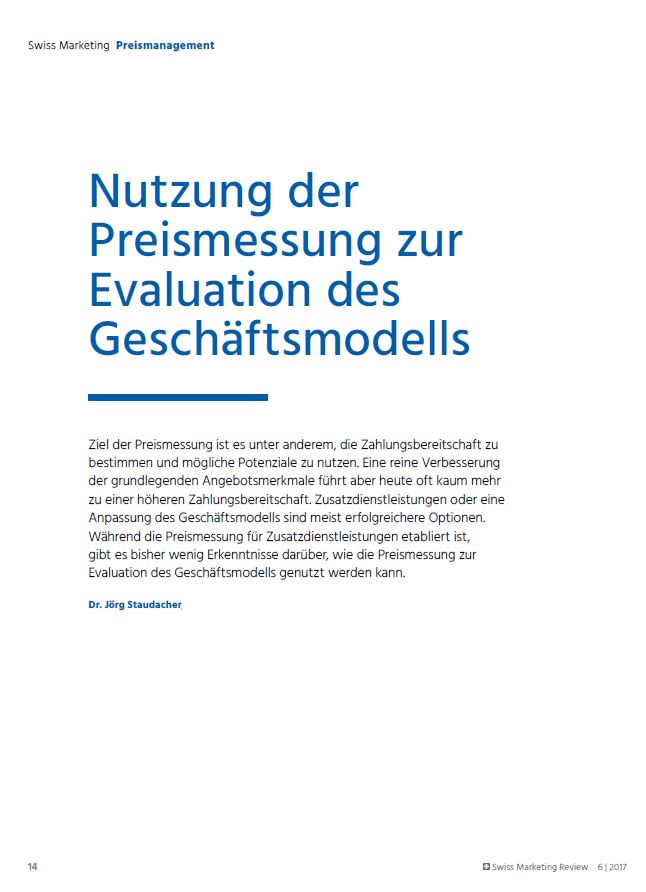Customers are paying more and more attention to price as a decision-making tool. You would think that price management would be a high priority for companies. Unfortunately, this is not the case. While functions such as communication are completely overemphasized, price management ekes out a shadowy existence. The impact of price management is much greater than other instruments in the company. We present our 5 recommendations for price management below.
1. recommendation
Establish customer-centric pricing: Prices can be determined based on costs, competition, and customers’ willingness to pay. While the determination of costs and competition is relatively simple, these types of determination do not allow a deeper understanding of the value perception by customers. However, which elements influence price perception and to what extent is important information for systematic management within the company. For product development, communication and sales, it is enormously helpful to understand which elements of the offer have the greatest influence on the customer’s willingness to pay. With this knowledge, decisions can be optimally aligned with the customer’s value perception and perhaps even different segments can be addressed in a differentiated manner. Thus, customer-centric pricing helps not only for optimal pricing, but also for further development of offers, differentiation of communication activities and success in sales.
2. recommendation
Establish competencies for price measurement: customer-oriented price determination requires that your company has competencies in the area of price measurement. 99% of companies have no competencies in this area. This gives you a huge opportunity to differentiate your company from the competition on the basis of these skills. In the meantime, this is no longer so difficult. There are numerous software applications for carrying out a choice-based conjoint analysis (CBC), Van Westendorp or Gabor Granger survey. The application and implementation are well documented. The software solutions calculate the results automatically and present them in an understandable way. We are now seeing that most of the papers in our master’s program are about customer-centric price measurement. Jump on the bandwagon and be a big step ahead of your competition. Those who understand their customers best have the best chance of success.
3. recommendation
Establish a clear price position and effective price differentiation: if you are able to measure customers’ willingness to pay, you gain greater confidence in determining optimal price positioning. People often think only in terms of cheap and expensive. But price positioning means fine positioning: how exactly do you position your company compared to your relevant competitors? And equally important, what are the arguments or differentiating factors for a higher price? Building on the fine positioning, it is important to check whether price differentiation is possible and to what extent? In doing so, the results of customer-oriented price measurement help you to determine the individual price points for each target group.
Unser Angebot im Bereich Preismanagement Beratung
Wir versetzen Dich in die Lage, die Zahlungsbereitschaft und die Relevanz der einzelnen Nutzenkomponenten Deines Angebots aus Sicht der Kunden ganz genau zu verstehen. Im Rahmen unserer Customer Purchase Process Analysis nutzen wir, je nach Fragestellung, die modernsten Preismesssungsmethoden. Auf Basis der daraus resultierenden wertvollen Kundenerkenntnisse, definieren wir gemeinsam die optimale Preisdifferenzierung und Preiskommunikation.
4. recommendation
Clear systematics in the discount system: if you have followed the first 3 of our 5 recommendations for price management, it would be a great pity to destroy all the work with a chaotic discount system. Thus, the discount system should also be critically reviewed. From the perspective of customer orientation, it is important to reconcile the freedom for the individual salesperson and the added value of uniform specifications. Try to keep the number of discount levels to a minimum. In this context, discounts should focus primarily on customer loyalty. If exceptional discounts are granted, this must be clearly marked for customers. Many companies give discounts without a disclosure of the actual cost to the customer.
5. recommendation
Continuous development of price management competencies: Customer experience management and communication are assuming such great importance in the public debate. Yet very few companies succeed in systematically improving their price management competencies. Most of the time, there is no pricing champion in the company. The sales team also has little expertise in this area. The introduction of a customer-centric price management commits every year to improve the price management competencies in your company. Price controlling plays an important role in this context.
Conclusion on our 5 recommendations for price management
We hear everywhere and all the time that customers are increasingly looking at price and that this is a high challenge for companies. What surprises us is that hardly any company is building up or expanding price management competencies. Customer surveys using the van Westendorp method or a choice-based conjoint (CBC) are no longer rocket science activities due to digitalization. Any company can use these methods. Customer-oriented price management not only helps with price determination, but is also a solid basis for decisions in offer development, communication and sales. The results can add value in many places in the company. Our final conclusion on the 5 recommendations for price management: customer-oriented price management enables security in decision-making, systematic learning over time and greater opportunities for differentiation in competition. The result: more growth and profit.
The article on the subject
Our article addresses the use of price measurement to evaluate new business models. By determining potential customers’ willingness to pay at an early stage, the potential and necessary investments in new business models can be better determined. Price measurement serves as a value assessment from the perspective of the customer and the company.






